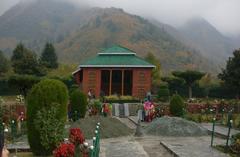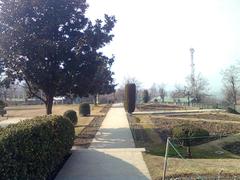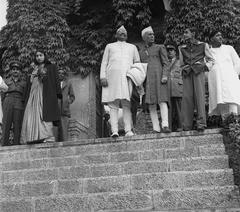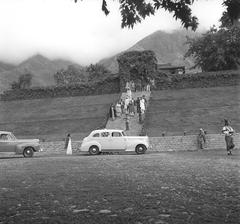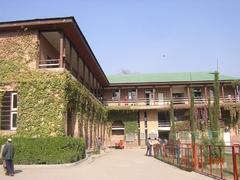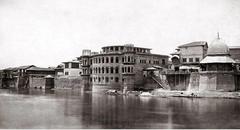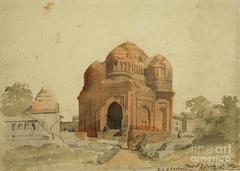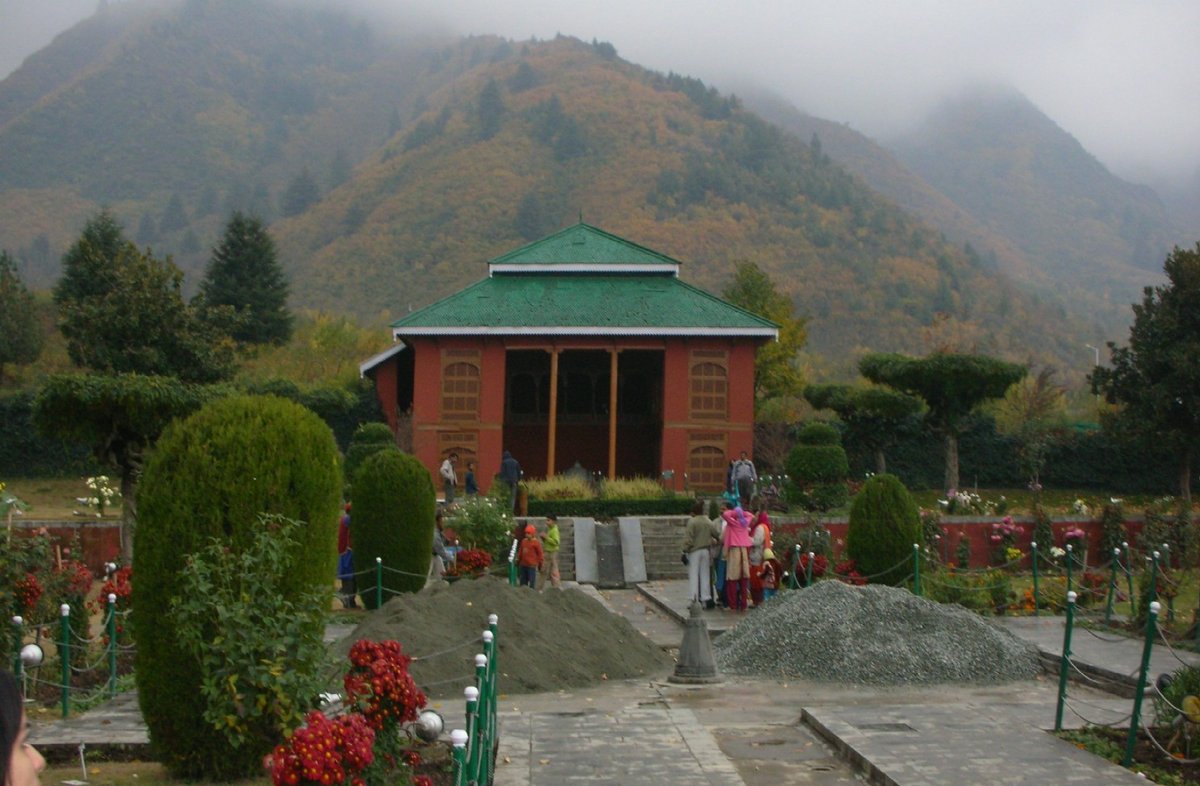
Chashme Shahi Srinagar: Visiting Hours, Tickets, and Travel Guide
Publication Date: 15/06/2025
Introduction
Chashme Shahi Garden, located in the heart of Srinagar, Kashmir, stands as a living testament to Mughal horticultural artistry and architectural finesse. Established in 1632 AD by Ali Mardan Khan under the patronage of Emperor Shah Jahan as a royal gift to Prince Dara Shikoh, the garden is a harmonious blend of Persian-inspired design, terraced landscapes, and advanced water engineering. The garden’s name, meaning “Royal Spring,” pays homage to the natural spring discovered by the revered Kashmiri saint Rupa Bhawani, whose waters are famed for their purity and medicinal properties (Srinagar District Official; Wikipedia; Chashme Shahi Garden; Capture A Trip).
Despite being the smallest of Srinagar’s famed Mughal gardens, Chashme Shahi enchants visitors with its thoughtfully designed terraces, fountains, lotus-shaped basins, stone pavilions, and panoramic views of Dal Lake and the Zabarwan mountain range. Today, it remains a well-preserved symbol of Kashmir’s layered history and Mughal legacy, attracting tourists, scholars, and nature lovers alike (TravelTriangle; Charzan Holidays; Thrillophilia; TravelMyKashmir).
Historical Overview
Chashme Shahi, translating to “Royal Spring,” was built in 1632 AD during Shah Jahan’s reign. The garden’s origins are deeply intertwined with local legend and spiritual reverence for its spring, which was discovered by Rupa Bhawani. The Mughal fascination with water and gardens—rooted in Persian tradition—made this site ideal for a royal retreat. Its original poetic gateway inscription references the year of creation, further cementing its historic significance (Wikipedia; Kashmir Tour Bazaar).
Design and Architectural Features
Chashme Shahi follows the charbagh (fourfold) garden layout, a hallmark of Mughal landscape design. Built over three terraced levels, each connected by stone stairways and water channels fed by the central spring, the garden features:
- Upper Terrace: Houses the main spring, sheltered in a red sandstone and marble pavilion adorned with Mughal arches and carvings.
- Middle Terrace: Contains a lotus-shaped basin and tank with a fountain, surrounded by vibrant flowerbeds.
- Lower Terrace: Features a larger tank with five fountains in a quincunx pattern and expansive lawns for relaxation.
The garden’s cascading water features symbolize the Mughal vision of paradise, with flowing water representing abundance and spiritual purity (Plan Ashley Go; Golden Wheels; Kashmir Life).
The Royal Spring: Myths and Medicinal Beliefs
Central to Chashme Shahi is its legendary spring, believed to possess healing properties. The water is cold, clear, and has been cherished since Mughal times—so much so that it was once shipped to India’s first Prime Minister, Pandit Jawaharlal Nehru, in New Delhi (Plan Ashley Go). Visitors today often drink from the spring or fill bottles to take home, continuing this centuries-old tradition (Chashme Shahi Garden).
Cultural and Political Significance
Chashme Shahi’s creation as a royal gift for Dara Shikoh underscores its political and cultural importance within Mughal narratives. Over centuries, the garden has survived various political eras, serving as a tranquil retreat and a symbol of the region’s resilience and heritage (Kashmir Vendor; Kashmir Life).
Visiting Hours, Tickets, and Practical Information
Opening Months: March to November (peak bloom: May–June)
Visiting Hours: 9:00 AM – 7:00 PM (may vary seasonally)
Entry Fee:
- Indian nationals: INR 20–50
- Foreign nationals: INR 50
- Children under 12: Free
Tickets are available at the entrance; exact change is recommended. Guided tours can be arranged on-site for a richer experience. Be sure to wear comfortable shoes and carry water, especially if you plan to explore all three terraces (TravelMyKashmir; Thrillophilia).
Accessibility and Facilities
The garden’s terraced design involves steps and uneven paths, with some ramps available. Visitors with mobility challenges may require assistance. Facilities include restrooms, shaded seating areas, and refreshment stalls near the entrance. Parking is available nearby (IndianHoliday).
Visitor Experience and Photography
Explore the terraces for unique perspectives, sample the spring water, and enjoy panoramic views of Dal Lake and the Zabarwan mountains. The garden is especially photogenic during spring and autumn, and photography is encouraged (tripods permitted; drone use requires permission) (TravelSetu).
Best Time to Visit
The optimal season is March–October. Spring brings blooming flowers, while autumn offers vibrant chinar foliage. Early mornings and late afternoons are ideal for tranquil visits and the best natural light for photography (Thrillophilia; IndianHoliday).
Nearby Attractions in Srinagar
- Nishat Bagh: The “Garden of Joy,” a twelve-terraced Mughal garden.
- Shalimar Bagh: The largest Mughal garden, famed for its water channels and pavilions.
- Pari Mahal: Mughal observatory with panoramic views, just 2 km away.
- Dal Lake: Ideal for shikara rides and houseboat stays.
- Indira Gandhi Memorial Tulip Garden: Asia’s largest tulip garden, open in April.
Other accessible sites include Shankaracharya Temple, Hazratbal Shrine, Botanical Garden, and Dachigam National Park (TravelSetu; Thrillophilia).
Travel Tips
- Footwear: Comfortable walking shoes recommended.
- Weather: Bring sun protection in summer, warm clothes in winter, and rain gear during monsoon.
- Etiquette: Respect local customs, avoid littering, and seek permission before photographing locals.
- Transport: Private taxis are most convenient; limited public transport is available.
- Safety: Garden is safe, but stay updated on local advisories and secure personal belongings.
Accessibility
While the garden’s terraced design may pose challenges, ramps are available in some areas. Those with mobility issues should plan accordingly and may require assistance.
Heritage Status and Conservation
Chashme Shahi is a protected heritage site, maintained by local authorities. Ongoing conservation ensures the preservation of its original layout, water systems, and plant varieties, safeguarding both tangible and intangible heritage for future generations (Srinagar District Official; Chashme Shahi Garden).
Frequently Asked Questions (FAQs)
Q: What are Chashme Shahi visiting hours?
A: 9:00 AM to 7:00 PM, March to November (may vary slightly by season).
Q: What is the entry fee?
A: INR 20–50 for adults; foreign nationals INR 50; free for children under 12.
Q: Are guided tours available?
A: Yes, local guides are available at the entrance.
Q: Is Chashme Shahi wheelchair accessible?
A: Only partially; ramps exist, but most areas involve steps.
Q: Can I take photographs?
A: Yes, photography is encouraged; tripods are allowed, drones require special permission.
Visuals and Media
High-resolution images of the garden’s terraced layout, the royal spring pavilion, fountains, and Dal Lake views enhance the visitor experience. Use alt texts such as “Chashme Shahi Garden terraced layout in Srinagar” and “Royal spring pavilion at Chashme Shahi” for accessibility and SEO.
Internal Links
External Links
- Vargis Khan on Chashme Shahi
- TravelSetu Guide
- TravelTriangle Srinagar Attractions
- Holidify Srinagar Sightseeing
- NRI Travelogue Srinagar Must-Visit Places
Summary & Recommendations
Chashme Shahi Garden offers visitors a unique blend of natural beauty, history, and Mughal architecture. Its terraced design, legendary spring, and panoramic views make it a must-visit in Srinagar. Proximity to other Mughal gardens and Dal Lake allows for a comprehensive exploration of Kashmir’s rich heritage. Plan your visit during spring or autumn for the best experience, and use the Audiala app for up-to-date information and travel assistance (Chashme Shahi Garden; TravelSetu).
